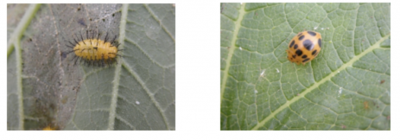Squash beetle: Epilachna borealis
By Jude Boucher, UConn Extension, 2014
The squash beetle (SB) is native to the Eastern United States and tends to be more abundant in states along the Atlantic Coast. It is one of two lady bugs or ladybird beetles that are common vegetable pests: the other being the Mexican bean beetle (MBB). Some growers mistake one pest for the other and think that the MBB has simply moved over to feed on their cucurbit crops. However, MBB usually feeds exclusively on legumes, while the SB prefers cucurbits. SB is an exceptionally large, yellow or orange ladybird beetle and is about twice the size of a copper-colored MBB.
Hosts and feeding injury: The SB feeds on squash, pumpkins, cucumbers, melons, gourds, and wild cucurbit weeds. Adults may also occasionally attack lima beans, cowpea pods, or even feed on corn silk. Larvae only feed on the underside of the leaf, while adults may feed on both surfaces or even on the rind of fruit, leaving spiral-shaped scars and causing cosmetic damage and marketability problems. Both adults and larvae start feeding by producing a trench around the leaf tissue that they intend to consume. The trench is thought to reduce the plants ability to excrete sap and chemicals that would hinder feeding. Larvae often trench in a semi-circular pattern at the leaf edge, or in a circular pattern in the middle of the leaf, and then consume the lower leaf tissue leaving the upper leaf surface (Fig. 1 & 2). Adults feed in a similar fashion but consume all the leaf tissue except for the small leaf veins (Fig. 3), and produce a lacy or skeletonized feeding patch. Late in the season, large numbers of adult beetles may be found feeding on the rind of a single or many adjacent squash and pumpkin fruit.

Description and Life Cycle: Adults overwinter under loose tree bark or under leaf litter near the edge of fields. They move back into fields to feed on cucurbit crops in June, deposit eggs in July, and larvae mature through four instars over the next three weeks, before pupating on the underside of cucurbit leaves. The entire development period takes four to five weeks. The next generation adults emerge in August and feed until September when they leave the field and seek shelter for the winter. They have a single generation in Connecticut but have two generations in the South.
Eggs are yellow and stand erect on the leaf surface in a loose cluster with space between each egg. The eggs resemble many beneficial ladybug eggs or even Colorado potato beetle eggs, which all tend to produce a tighter egg cluster. Females lay up to 400 eggs in batches of approximately 45 eggs. Larvae are yellow with six rows of barbed, black spines (Fig 4). Adults are orange or yellow and have twelve large, black spots on the wing covers and four smaller spots on the thorax, just behind the head (Fig. 5).
Natural Enemies: Eggs are often consumed by larvae and adult SB and other lady bugs. SB can also be attacked by stink bugs, assassin bugs or parasitized by Tachinid flies.
Management: Usually SB exist in such small numbers that they do not require control. There are no established thresholds. However, extensive defoliation on young plants, or direct fruit feeding, may necessitate management. Scouting is best done in the middle of sunny days. SB are not strong fliers, so crop rotation to distant fields tends to limit colonization and populations. However, when production space is limited, populations can build up until it becomes an economic pest. Hand picking may be practical in very, small gardens. Harrowing and destroying vines and larvae in July, after harvesting early squash and cucumber plantings, can help limit populations. Row covers can exclude the beetles from cucurbit crops and prevent damage. Several common insecticides will control SB, including endosulfan (i.e. Thionex), lambda-cyhalothrin (i.e. Warrior), pyrethrins (i.e. Pyrenone or PyGanic), and spinosad (i.e. Radiant or Entrust). PyGanic and Entrust are OMRI approved for use on organic farms.
The information in this document is for educational purposes only. The recommendations contained are based on the best available knowledge at the time of publication. Any reference to commercial products, trade or brand names is for information only, and no endorsement or approval is intended. UConn Extension does not guarantee or warrant the standard of any product referenced or imply approval of the product to the exclusion of others which also may be available. The University of Connecticut, UConn Extension, College of Agriculture, Health and Natural Resources is an equal opportunity program provider and employer.